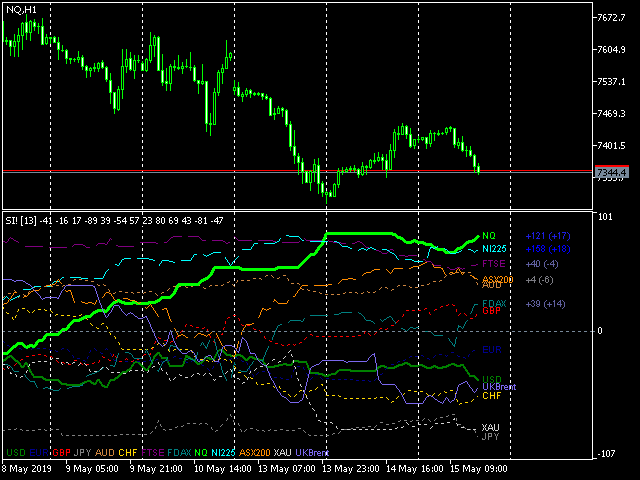Successful trading is challenging. One of the reasons for this is that almost any market is an open system. It's affected by unpredictable events which happen outside. This is obvious if you trade a single instrument. For example, analysis of EURUSD pair as a sole symbol leaves the entire Forex behind the scene. But even Forex does not live on its own - it closely bound to other markets, such as stocks, metals, raw materials, etc.
The more assets are counted during analysis, the better for trading system, because the "open system market" becomes more and more self-contained and hence predictable. The assets should be various to cover different branches of the world market.
The analysis of a selected group of assets is called cluster analysis. You can perform it using many tools, such as SuperIndices indicator. And you can trade signals of this indicator using the expert adviser MarketGauge.
2 main parameters of EA are:
- IndicatorSymbols - a comma separated list of market symbols passed to the underlying indicator; this is the cluster being analyzed; right after downloading EA, enter a cluster containing several instruments (maximum - 15); the more instruments you specify, the better - it increases the accuracy of signals;
- TradeSymbols - a comma separated list of work symbols allowed for trading (without quotes, no spaces); empty by default, which means trading current chart symbol only; it's recommended to specify several symbols for more stable results; all trade symbols should derive from the cluster symbols directly or indirectly, and they must exist on your server; for example, having EURUSD and USDJPY in the cluster one may trade EURJPY; but having XAUUSD and EURUSD does not allow to trade XAUEUR if your broker does not provide this ticker;
For trading Forex, it's recommended to include into the cluster not only Forex pairs, but also CFDs for major indices, gold, oil. Here is an example of the cluster for analysis:
IndicatorSymbols=EURUSD,GBPUSD,USDJPY,AUDUSD,USDCHF,USDCAD,NZDUSD,FTSE,FDAX,NQ,NI225,ASX200,XAUUSD
The added indices are: FTSE (GBP), FDAX (EUR), NQ (USD), NI225 (JPY), ASX200 (AUD). Tickers may differ at your broker. The indices is used for analisys, but not for trading. Only main Forex pairs should be specified, not crosses.
And here is an example of symbols for trading:
TradeSymbols=EURUSD,GBPUSD,USDJPY,AUDUSD,USDCHF,XAUUSD,EURGBP,EURCHF,GBPCHF,AUDJPY,GBPJPY,EURJPY,USDCAD,NZDUSD
Here you can see Forex majors and some their crosses (not necessary all possible crosses, which may have too big spreads). You may specify any combination of currencies mentioned in the cluster and available at your broker as a ticker (for example, some may not have GBPNZD).
The trading strategy is to buy assets in upper part of the indicator and sell assets in lower part. You can choose the signal strength for entering and exiting the market (see below). If the signal becomes stronger by predefined step, it's possible to increase existing position.

Actually, you are free to select your favorite instruments in the cluster, and trade any combination of them. But there are some nuances.
It's not recommended to trade indices in the same cluster which is used for trading currencies. Every index is quoted in corresponding national currency, so it exhibits strong reverse correlation with this currency. Buying the index means selling the currency, and vice versa, selling the index means buying the currency. In such a couple of assets, movement in opposite direction is a normal tendency which have no limits and overbought/oversold states (due to the openness of the system). The limits can be found in external actions or in more complete system - for example, by extending the cluster with similar indices.
Specifically, for trading indices it's recommended to form a cluster with many indices with the same quoting currency. Based on the signals of such cluster, only indices should be traded, not currencies. For example, for USD one can use SP (S&P500), NQ (Nasdaq), DJI (Dow Jones), for EUR - STOXX50, DAX, CAC40, IBEX35.
Also clusters built on specific industry CFDs (goods, stocks) show good performance. You may try oil and gas, metals, cryptocurrencies clusters.
In all such cases trading is performed on tickers of selected industry (TradeSymbols), but the entire picture of the market is built with assets in a wider spectrum (IndicatorSymbols).
Another important parameters are LevelEnter, LevelStep, LevelExit.
- LevelEnter - minimal signal level for opening position; this is a difference between 2 indicator lines as % of entire market range (which is 100%); by default - 75%; position exists after the signal crosses LevelEnter up and up to the moment the signal crosses LevelExit down;
- LevelStep - additional increase of signal strength (%), after which another market order is placed; by default - 12%; for example, if position is opened at level 75%, it can be enlarged when signal goes above 87%, and then when/if it reaches 99%;
- LevelExit - minimal signal level for keeping position, if signal goes below it position is closed; the value is % of entire market range;
These parameters should be optimized. It's supposed LevelEnter > 50 and LevelEnter > LevelExit.
To choose lot sizes one may use one of modes:
- FixedLot - fixed lot size for all instruments; 0 by default, which means minimal lot;
- ExposureLot - percent of free margin to use, in other words - this is additional exposure implied by new lot; fractions are allowed, for example, 10 - 10%, 0.5 - 0.5%; 0 - disabled;
- RiskLot - lot is calculated from potential loss as a percent of equity, which may occur as a result of unfavorable price movement for latest weekly range (detected dynamically for every instrument and respects point value);
RiskLot is recommended. A fraction of percent means conservative trading (40% annual), 10% is for aggressive trading (100% annual and above), depending from number of symbols being traded and size of deposit.
Recommended timeframes - H1, H4, D1.
You may find more details, examples and sets on the product page.


